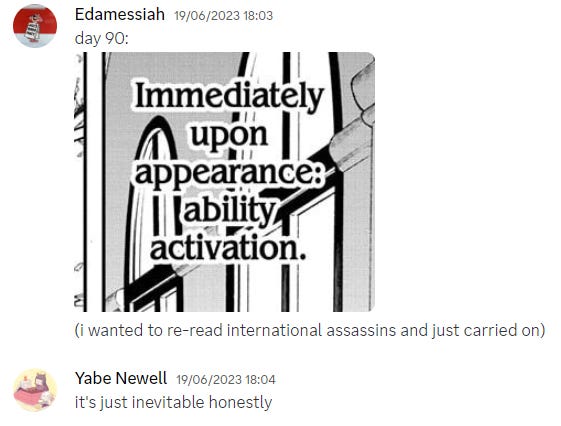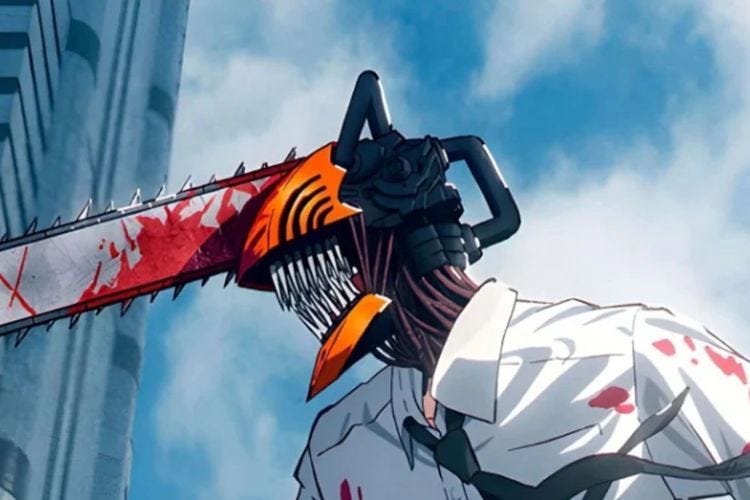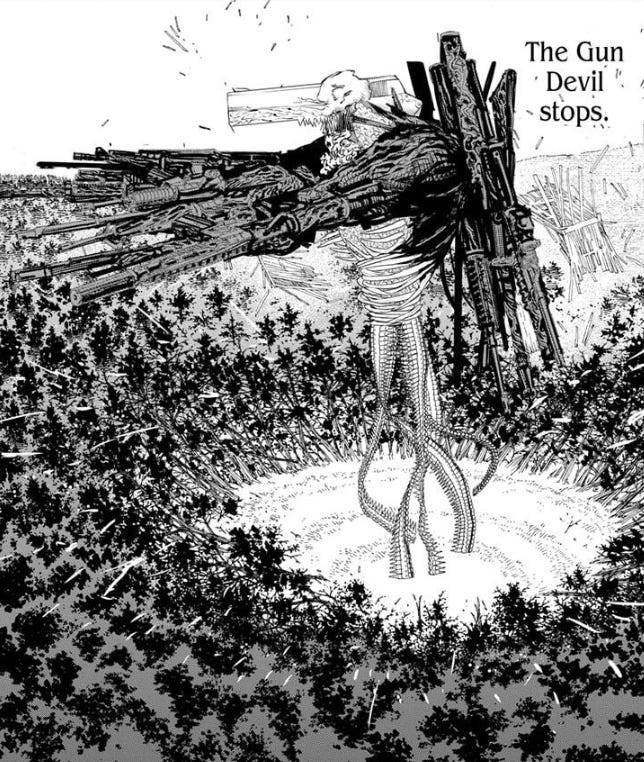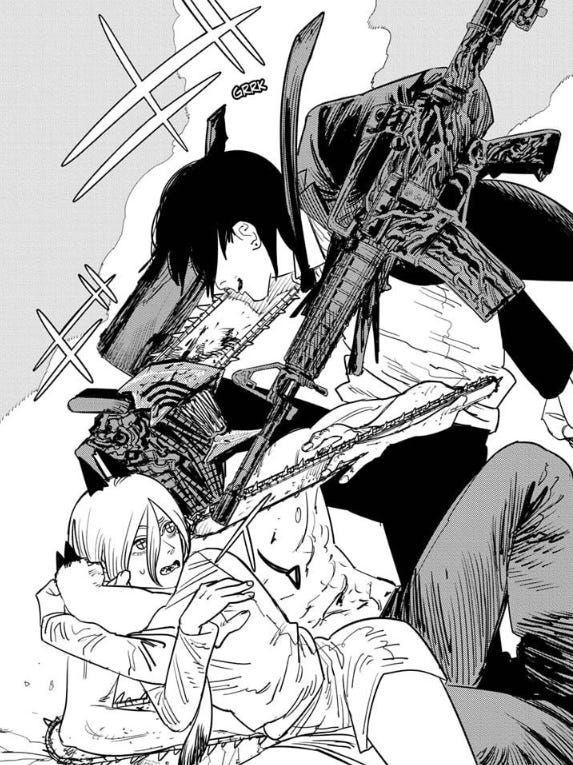If I Don’t Talk About The Gun Devil From Chainsaw Man I Am Going To Go Insane In The Head
It's made of fucking guns, man, what the fuck.
[This piece will contain spoilers for season one of the Chainsaw Man anime from the outset. An additional warning will advise when spoilers for the manga begin. Content warnings for gun violence and mass shootings apply.]
I Love You, Chainsaw Man
Last year, MAPPA studio’s anime adaptation of Tatsuki Fujimoto’s smash hit manga Chainsaw Man was released. Its ten episode run comprises the first 4 arcs of the manga’s first part, which concluded in 2020. Part 2 is currently being released on a weekly (or sometimes biweekly) basis.
I was hooked by the first trailer as soon as I laid eyes on it. An Attack on Titan junkie in earnest already, the promise of frenzied, frenetic animated violence was compelling enough, plus the sinister tone of the trailer’s quieter moments, with that undeniably-alluring score reminiscent of Silent Hill 2’s more reflective tracks promising a heart of darkness to sink my masochistic teeth into. Teeth like a saw. Like a chainsaw. You get the picture.
The trailer got my blood up. The anime delivered in a way I couldn’t have possibly prepared for.
I was enthralled. It became my obsession. Watching, rewatching, dragging friends into it with me to gawk and wonder at their reactions to highlight moments like episode 8, GUNFIRE, or Makima’s jaw-dropping counterattack during episode 9, FROM KYOTO. I invented a drinking game to compel my audience in, but the show requires no mental lubrication to enjoy. It is utterly masterful. It’s polished to a mirror shine. On a numeric scale, it’s one of the big ones, it’s like a really big number, like a 367 out of 100, or something.
Needless to say, I wanted more, and I wanted it straight away — the wait for the inevitable (yet unannounced) second season simply would not do. I am not a good reader of manga; I couldn’t tell you why. My aforementioned love of Attack on Titan extends only to its anime (approaching a conclusion later this year, in theory). Although I did read the ending in the time following the increasingly-misnamed Final Season’s second part, I only read from where the anime left off to the end. Other shows I’ve loved, I haven’t touched so much as a page of the manga. Mea culpa, mea culpa.
I tell you this so you can understand the sincerity of my devotion when deciding to read Chainsaw Man’s manga in its entirety in the span of a single evening. And then going back later and doing it again.
I mean, it speaks for itself. It’s fucking incredible. You don’t need me to tell you that, and if you’re this far in without having read it — what are you doing? It’s out there, it exists, you can read it! And you should! Then read Fire Punch and feel your brain get excavated page by page like a limestone quarry. Then come back. We’ve got a lot to discuss.
Or press on. It’s your call, I’m not your mum.
[Manga spoilers begin here. These spoilers, to the best of my ability, only include details of the Gun Devil arc, without alluding to anything before or after]
There’s so much going on in this God damn manga, and to say Fujimoto does a lot in a comparatively short run of chapters — 97 total in the first part — would be like saying Gaudí’s Sagrada Família is a ‘pretty fancy church’. I could ramble eternal about the beautiful themes of trauma, grief and growth present in this - let me double check here - story about a guy with chainsaws for hands, but that isn’t really the highlight that’s haunted me every single day for three months now.

The Gun Devil: a recap
If you’re already familiar, having been infected with the same brain-worm as myself and forced to scour all available material on this subject, do feel free to skip this section. Otherwise, let’s refresh our memory together.
The Gun Devil is first mentioned in chapter 12, and expanded upon in chapter 13, aptly entitled ‘Gun Devil’. As per Makima’s account, it’s a monstrously powerful devil, far exceeding the threat of the others shown in the story up to here, or indeed for a long while after. Though the entity itself isn’t shown or described at this point, its effects are made clear:
Within five minutes of its first appearance, the Gun Devil slaughters 1.2 million people around the world, including the family of deuteragonist Aki Hayakawa, leading to his character-defining hatred of the entity, a vendetta which compelled him to join the ranks of the hunters in Public Safety and expend any cost in his pursuit.
It’s worth noting that the Gun Devil isn’t much of anything to protagonist Denji — just a ‘final boss’ standing between him and his dreams of a romantic relationship with his handler, Makima. This is one of the bait-and-switches Fujimoto enjoys in his work, a man who is on record as stating he loves it when a Big Deal is set up in a story only to be foiled way ahead of schedule. As such, I would imagine any veterans of his previous work had tongues firmly in cheek when reading this chapter upon its release. Fool me once, Fujimoto-san, shame on you, etc.
Regardless, the Gun Devil serves as a motivation for Denji to stay on as a devil hunter (the carrot, in comparison to the fairly hefty stick of a promised execution should he quit), and for about 50 chapters, that’s all it is. It’s a big scary monster for Denji to rev up and take down, eventually, a promised spectacle awaiting at the end of however many side stories it takes to get there.
Fool me twice, shame on me.
In a blindside, the operation to take down the Gun Devil is announced, with nary a moment for the cast to catch their breaths after quite literally going through Hell only pages before - and before you can recover from that, Makima casually announces that the Gun Devil is already dead and defeated, and its carcass shared among world powers like a stockpile of nuclear weapons. Quite an upset! Where’s that awesome battle, Chainsaw versus Gun, we were promised in chapter 13? This ain’t that kind of story.
No, instead what’s on the cards is ‘a kind of war’, as per Makima’s description, which is of course disconcertingly vague. What’s proposed is a sort of smash-and-grab, to subdue the remnants of the Gun Devil in whatever form they now occupy and take them from the various international superpowers, in whose possession they pose a grave and existential threat.
The apocalyptic implications of its current status aren’t lost on Aki, either:
Before long, Aki finds himself heading (perhaps compelled) to Makima, who is standing alone on a beach, apparently waiting for something. Concerned by a prophecy from the Future Devil to which he is bound, he asks for Makima’s help in safeguarding Denji and Power - his newfound family - from the grim events he sees ahead. She offers him ‘strength’ in some unspecified form, and all she wants in return is for him to surrender himself completely.
Which he accepts.
Shortly after this, we cut to the President of the United States, opining that Makima herself represents a threat to the Union and invoking America’s 20% of the Gun Devil’s body, offering one year from the lifespan of every American citizen in exchange for her assassination.
The next panels… oh boy. The next panels depict what the Gun Devil does in the handful of seconds that follow.
Putting it like that feels like trying to take a photo of the Moon on your phone camera: it’s a pale and shoddy image and nothing else. That’s what you see. It’s not what happens.

Before we even see more than the ‘tail’ of the Gun Devil dangling in the sky above Nikaho, a church choir is ripped to shreds by a hailstorm of bullets, as superimposed text dispassionately describes the Gun Devil’s supernatural abilities, targeting ‘every adult male within approximately 1,000 metres’ and ‘every child (ages 0-12) within approximately 1,500 metres’. The account reads like a news report following a natural disaster.
On top of these images, a list of names.
A death toll.
A complete death toll.
And at last, the Gun Devil itself. The pages below are presented in their entirety.
The next chapter begins, chronicling the Gun Devil’s devastating yet somehow meticulous rampage towards Makima. The expanding list of the dead never leaves us, following us from panel to panel as new abilities ‘activate’ and find new targets in the hundreds of miles between Nikaho and Makima.
Finally, Makima invokes a cornucopia of bound devils from her thralls - Aki among them - dropping an avalanche of unspecified infernal power directly on top of the Gun Devil. Smash cut to a black panel before the effects are shown.
I say ‘finally’, and I am lying to you. From activation to defeat spans seven seconds. Seven seconds in which more names than I am willing to count haunt every panel, with ‘Aki Hayakawa’ no more than a single line amongst them.
This isn’t the end. But it’ll do for now.
The events from its activation to its defeat have been adapted to truly marvellous effect into a motion manga, which you can - and SHOULD - watch here. I’ve watched it maybe 30 times in the last three months.
What is the Gun Devil?
So let’s talk about this fucking thing already.
The only panels that give us any perspective on the Gun Devil’s enormous size are the teaser of the church shown above, and this panel depicting the thing hovering over a forest:
You’ll note two things: one, that it’s many times the height of the trees below (they look like palms to me, but I’ll leave the flora identification to you), and two, that it’s exerting enough sheer pressure to almost flatten the trees below it, resembling the effect of a helicopter on grass. It’s big.
This is 20% of it.
What the body comprises is a cartoonish arsenal of assault rifles - and, of course, the iconic design of the M1911 handgun embedded in its head. This assemblage of weaponry protrudes at jarring, spiky angles from a skeletal body, human faces bulging out of a tumorous mass in its chest and machine gun ammo belts dangling from its lower torso like the spilled intestines of which Fujimoto is notoriously fond.
A more stylised version of this over-the-top design wouldn’t be misplaced in some dark doppelganger of Looney Tunes, more guns than one could feasibly aim bursting out of a body like the biomechanical mutations of Akira’s climax.
Let’s break it down a little. Let’s talk about what this monster means.
The Guns
According to the Chainsaw Man Wiki, the guns on its arms and back include M4 Carbines, AK-47s, M16A1s and Mk18s, all recognisable assault rifles from any number of films, games and - of course - real world armed conflicts. I say films and games first and foremost, because I believe the recognisability of these weapons to even people who haven’t carried out any military service is highly significant.
This isn’t a devil representing people killing each other in war. Let’s be 100% clear about this. This is a devil unambiguously representing civilian casualties.
There’s no coincidences involved in the fact that it’s the USA that invokes this incarnation of the Gun Devil, nor that the date of this event in the story and the chapter title of its appearance - 9, 12 - echo the most famous terrorist incident in history, which I needn’t describe. Mass shootings represent a weekly or sometimes even daily incident across America, with 203 carried out in the first five months of 2023 alone. Guns aren’t the domain of trained soldiers; they’re something you see in the news, in your shops, maybe in your home. If you’re a parent or a teacher in the States, they’re something you prepare your children to encounter at school.
The Gun Devil doesn’t kill any soldiers, or if it does, that’s not the context in which they’re killed. It kills unarmed civilians - and among its other alarmingly specific targeting rules, it aims for children specifically.
It matters that these are guns people know. It matters that you can see a handgun like the M1911 and know what it is, perhaps know a bit of its history since its use in World War 1 and most armed conflicts since, maybe even its status as a beloved staple among other handguns, improved upon but never significantly changed.
It matters that I know this all off-hand, about a gun I’ve never encountered and sincerely hope not to. Why do I know this? Because guns, in whatever sense you care to name, are inescapable. They are a fact of the world we occupy. Like monsters of ancient folklore, they live in our imagination, our stories, and they haunt our reality with constant threat. Like the devils of old.
The Names and Faces
I’ve endeavoured to include every head in this screenshot. Maybe I take things too seriously, but I believe in memorials. I believe in names and faces for the dead.
We can speculate freely about this, but I think the most immediately vivid interpretation of this aspect of the Gun Devil’s physiology is of a mass grave. Names float around the devil, faces claustrophobically meshed together within an imprisoning cage of spiky ribs - a vivid refutation of the oft-repeated idea that mass shootings are the so-called “price of freedom”. No name is matched to a face, no face to a name. How often this is the case.
We might also - slightly more harrowingly - take each face to represent a mass shooting of its own, each head an amalgamation of all victims per case. If so, half of this mass would not account for each incident in this year alone. As I write this, it’s June.
To observe that every face is contorted in pain, that they are all stripped of identifying features such as hair, communicates only as much as we’ve already seen. You can look at this, you can see what it’s doing; it requires no leaps of the imagination to fathom why a devil representing the fear of guns features so prominently a gallery of anguished human beings. In other words, you already know why it looks like this, because you and I live in a world in which a week without a headlined massacre is a rarity.
In a better world than ours, this metaphor would require analysis and explanation. As things are, it speaks for itself.
The Abilities
One might find it curious that a devil representing wholesale slaughter seems to follow an alien yet consistent internal logic. The Gun Devil’s ‘abilities’ are listed below in order of activation:
Ability to fire a bullet through the head of every adult male within approximately 1,000 metres of the Gun Devil.
Ability to fire a bullet through the head of every child (ages 0-12) within approximately 1,500 metres of the Gun Devil.
Ability to fire a bullet through the heart of every living thing born in the months of January, February, March, May, June, August, September, November or December within approximately one kilometre
Gunfire toward Makima
I found the month-based ability particularly perplexing. Why exclude April, July and October? Someone more observant than I - username @negativephoton on Youtube - put it as such, in the comments on the motion manga of this chapter linked previously:

This, to my mind, evokes the specifically supernatural nature of the Gun Devil, tying it to the rules that devils are bound to follow in myth - the uncrossable salt circles, the Faustian contracts, and so on. It separates it from guns themselves, which (whatever firearm lobbyists might have you believe) are bound by no restrictions and exclude no targets. It highlights the terror of gun violence, by demonstrating that even otherworldly manifestations of evil and fear obey their own laws. Devils discriminate. Devils play a wicked game, but they play it by the rules. Real guns don’t.
Again, the targeting of children - and at greater range than adults, you may notice - speaks for itself. We shall dwell no more on that. What we should observe is that only after hundreds upon hundreds of bystanders are slaughtered does the Gun Devil even begin to aim for its actual target. Who is the intended victim of a massacre, after all? Rarely any one person. Sometimes, though not always, a particular group. The goal is to kill a lot of people. It doesn’t matter who.
Aki Hayakawa
I mentioned before that the apparent ‘defeat’ of the Gun Devil is not the end of this section, so let’s pick up where we left off.
We cut from Makima’s attack, apparently about to obliterate the Gun Devil, to Denji and Power, minding their own business at home. They’re on standby for the operation on which they’ve been sparingly briefed, but it’s otherwise an uneventful afternoon.
The doorbell rings. Again and again, the doorbell rings. Denji is warned by his inner voice (Pochita) not to open it.
The phone rings. From the other end of the call, Makima bluntly informs Denji that the Gun Devil, now in Fiend form (meaning it has possessed a human corpse) is at his door, and he must go kill it.
Power is adamant that it’s actually Aki at the door, whatever Makima says. As you’ve probably guessed - or already know - they’re both right.
There’s a lot of heart-rending, gut-punch panels in Chainsaw Man, exemplified by the full depiction of the Gun Devil I shared earlier, but this one is perhaps the most upsetting. There is nothing Aki despises more than the Gun Devil. It took his family before his eyes, leaving him alone in a world of senseless brutality and ignominious death at a moment’s notice, catalysing his deliberate pattern of self-destruction and throwing him into a quest for vengeance he knows will only end in his own death.
There is nothing he more vehemently detested than the monster now inhabiting his corpse.
This desecration is vile enough, but we soon learn it’s even worse. Somewhere deep inside his own reanimated body, what remains of Aki half-dreams of his stolen youth. He sees himself on the snowy path outside of his childhood home. He starts a snowball fight with Denji, reveling in the simple pleasures of a lost innocence.
In reality, his ‘snowballs’ - fired from an assault rifle arm - level buildings and slaughter civilians. As Denji and Power try and subdue him, he throws blizzards of ammo at the found family he gave up his free will and the last moments of his life to protect.
Aki was only one name on a long list among the Gun Devil’s death toll on the previous pages, and here we see the tragedy unfold more directly. If the seven second rampage shows us the death and destruction on a massive scale, the fight between Denji and Aki - Chainsaw vs Gun at last - shows us the Greek tragedy of it: a hero devoured by his enemy, helpless in the end, with no satisfaction and no happy ending. The symmetry of it is immaculate and terrible. Aki’s entire life was lived as a slave to the influence of the Gun Devil, and in the end, so too is his death.
What do we take from this, in the grand scale of the Gun Devil’s rich theming? Many things. For me, most stark is the message that gun violence robs the dead of their identity. Aki is first a statistic - a name on a list - then a corpse defined by the guns that made him one. His face is erased, a barrel staring out of a death mask.
How should we recognise the dead taken by gunfire? Firstly, by the holes. By the ‘no longer there’.
Conclusion
I’ll be thinking about these chapters forever, I think. The promise of future seasons of the anime tantalises me with wonder about how they’ll choose to put into motion this sequence, nothing short of groundbreaking in its mode and perhaps one of the most striking commentaries on gun violence in popular media. The motion manga - linked again for your convenience, since you surely won’t only watch it once - gives some ideas, most prominently the barrage of names faster than they eye can process between shots of the destruction unfolding. But we won’t know until we know.
The Gun Devil is a haunting thing, a jarring eruption which - like the violence of its namesake - manifests without warning, leaving panic, horror and death where it has been. We should find such a thing in fiction as alien and unimaginable as zombie apocalypses and nuclear wastelands, grim warnings of what could be, but isn’t. I think you know why we don’t.
I look forward to seeing this sequence animated. I hope to see it brought to life. I hope for it to upset, to disquiet, to chill, to horrify. Grandly, and with foolish and reckless optimism, I hope for something to come unstuck, for our world to change, for ‘thoughts and prayers’ to become ‘never again.’
Mostly, I hope they keep the list of the dead.












